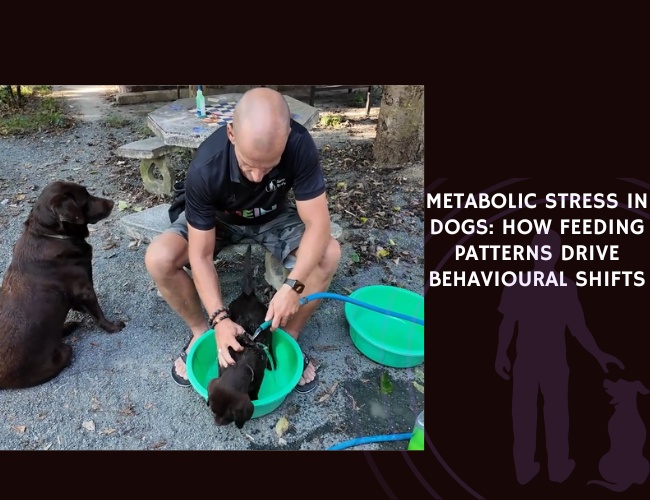Introduction: The Hidden Link Between Your Dog’s Bowl and Brain
Have you ever wondered why your normally sweet-tempered companion suddenly becomes irritable before dinner time? Or noticed how your dog’s energy crashes after certain meals? You’re witnessing the profound connection between feeding patterns and canine behavior—a relationship that extends far beyond simple hunger pangs. This intricate dance between metabolism and mood shapes everything from your dog’s training success to their emotional stability throughout the day.
For decades, we’ve focused on what we feed our dogs, but emerging research reveals that how and when we feed them might be equally crucial. The metabolic processes triggered by feeding patterns create ripple effects through your dog’s entire physiological system, influencing stress hormones, blood sugar stability, and ultimately, their behavior. Let us guide you through this fascinating intersection of nutritional physiology and behavioral science, where glucose regulation meets emotional regulation, and feeding schedules can make or break training progress.
As we explore this complex relationship, you’ll discover how simple adjustments to feeding routines can transform a reactive, anxious dog into a calmer, more focused companion. This isn’t just about filling bowls—it’s about understanding your furry friend’s metabolic needs as a foundation for their behavioral wellness. 🧠
Feeding Frequency & Behavioral Stability
Understanding Your Dog’s Metabolic Rhythm
Your dog’s mood stability throughout the day isn’t random—it follows predictable patterns tied directly to their feeding schedule. When we examine how feeding frequency impacts behavior, we’re really looking at how your dog’s body manages energy availability and the psychological anticipation that builds around mealtimes.
The twice-daily advantage emerges clearly from research. Dogs fed twice daily show more stable blood glucose and insulin levels compared to once-daily feeding, creating a metabolic foundation for emotional equilibrium. Think of it like this: consistent energy input means consistent energy output, both physically and emotionally. Your dog’s brain receives steady fuel, reducing those dramatic peaks and valleys that can trigger behavioral issues.
Anticipatory behaviors and feeding predictability create an interesting paradox. While predictable feeding schedules help dogs feel secure, they can also generate intense anticipatory arousal—that pre-dinner pacing, whining, or demanding behavior you might notice. This “food anticipatory behavior” reflects your dog’s internal clock synchronizing with external feeding cues. The key lies in finding the sweet spot between predictability (which reduces anxiety) and flexibility (which prevents obsessive anticipation).
Individual variation in metabolic needs means there’s no one-size-fits-all approach. Some dogs, particularly those with higher metabolic rates or anxiety tendencies, benefit from smaller, more frequent meals. Others thrive on a standard twice-daily schedule. You might notice your Border Collie needs different feeding patterns than your Bulldog—and you’d be absolutely right. Breed-specific metabolic sensitivities play a significant role in determining optimal feeding frequency.
The Stress of Irregular Feeding
When feeding schedules become unpredictable, your dog’s stress response system kicks into overdrive. This isn’t just about being hungry—it’s about the fundamental disruption of circadian rhythms and the cascade of hormonal changes that follow.
Cortisol disruption and behavioral fallout occur when dogs can’t predict their next meal. Research on various species shows that irregular feeding disrupts the normal cortisol rhythm, leading to chronically elevated baseline stress levels. In your dog, this manifests as increased vigilance, difficulty settling, and potentially reactive behaviors. That seemingly random barking at nothing? It might be metabolic stress speaking.
The uncertainty factor creates a state of chronic arousal. Dogs evolved to conserve energy between hunting opportunities, but domestic life with irregular feeding creates a mismatch—they’re constantly “on alert” for the next meal opportunity. This sustained arousal depletes mental resources needed for learning, impulse control, and emotional regulation. You’re essentially asking your dog to function optimally while their brain is preoccupied with basic survival concerns.
Building predictable routines doesn’t mean rigid scheduling down to the minute. Instead, create reliable patterns your dog can anticipate without becoming obsessive. For example, feeding after morning and evening walks creates a predictable sequence without clock-watching precision. This approach satisfies your dog’s need for routine while preventing the intense anticipation that can develop with exact timing.
Glucose Regulation & Energy Management
The Glycemic Rollercoaster Effect
Your dog’s post-meal behavior tells a story written in blood sugar levels. Understanding glycemic response—how quickly and dramatically blood glucose rises after eating—provides crucial insights into those mysterious mood swings and energy crashes you might observe.
High-glycemic foods and behavioral volatility create what we call the “sugar rush syndrome” in dogs. Foods that rapidly spike blood glucose (think simple carbohydrates, certain commercial treats) trigger an insulin surge, followed by a dramatic drop in blood sugar. During the spike, you might see hyperactivity, inability to focus, and heightened arousal. During the crash? Irritability, lethargy, and increased stress-seeking behaviors emerge. It’s like watching your dog ride an invisible emotional rollercoaster.
Low-glycemic alternatives for stable behavior work by releasing glucose slowly and steadily into the bloodstream. Complex carbohydrates, certain vegetables, and foods high in fiber create this desirable metabolic profile. Dogs fed low-glycemic diets show more consistent energy levels, better training focus, and reduced anxiety-related behaviors. The difference can be remarkable—owners often report their “crazy” dog suddenly becomes manageable simply through dietary adjustment.
Practical application in daily feeding means examining not just what’s in your dog’s bowl, but how those ingredients interact metabolically. For instance, adding fiber-rich vegetables to a meal can lower its overall glycemic impact. Feeding protein alongside carbohydrates slows glucose absorption. These simple modifications create metabolic stability that translates directly to behavioral stability. 🐾
Hypoglycemia and Behavioral Crisis
When blood sugar drops too low, your dog’s brain enters crisis mode. Hypoglycemia—even mild, subclinical forms—can trigger profound behavioral changes that owners often misinterpret as training issues or temperament problems.
Recognizing hypoglycemic behaviors requires understanding the subtle signs. Sudden irritability, especially between meals, might indicate blood sugar instability. Trembling that isn’t temperature-related, difficulty concentrating during training, or unexpected aggression toward food or resources can all signal metabolic distress. These aren’t character flaws—they’re physiological SOS signals.
The anxiety-hypoglycemia connection creates a vicious cycle. Low blood sugar triggers the stress response, releasing cortisol and adrenaline. These hormones mobilize glucose but also heighten anxiety and reactivity. Your anxious dog becomes more anxious, creating a feedback loop that’s difficult to break without addressing the underlying metabolic issue. This explains why some dogs seem to spiral from mild stress into full-blown panic—their metabolic state amplifies their emotional response.
Prevention through strategic feeding involves maintaining steady glucose levels throughout the day. This might mean offering a small, protein-rich snack between meals for dogs prone to hypoglycemia. Working breeds, puppies, and small dogs with fast metabolisms particularly benefit from this approach. Think of these snacks as metabolic insurance policies—small investments that prevent major behavioral crashes.
Hormonal Pathways & Stress Response
Cortisol, Feeding Times, and Daily Rhythms
The relationship between feeding schedules and cortisol secretion reveals why meal timing matters as much as meal content. Your dog’s stress hormone system evolved to anticipate and respond to feeding opportunities, creating complex interactions between hunger, stress, and behavior.
Synchronizing feeding with natural cortisol rhythms optimizes your dog’s metabolic and emotional state. Cortisol naturally peaks in the morning, preparing the body for daily activities. Feeding during this natural high can help regulate the entire day’s hormone cycle. Evening feeding should align with the natural cortisol decline, supporting relaxation and sleep preparation. Misaligned feeding times fight against these biological rhythms, creating unnecessary metabolic stress.
The fasting stress response becomes problematic when periods between meals stretch too long. Extended fasting elevates cortisol as the body perceives potential starvation, even in well-fed domestic dogs. This evolutionary mechanism, useful for wild canids, creates problems in modern pet life. That early morning whining or late-night restlessness? Often it’s cortisol elevation from extended fasting, not “bad behavior.”
Breed-specific hormonal sensitivity adds another layer of complexity. Herding breeds, with their intense focus and high metabolic demands, may show more dramatic cortisol fluctuations with feeding changes. Brachycephalic breeds, dealing with respiratory challenges, experience additional stress when metabolic demands aren’t met consistently. Understanding your breed’s specific vulnerabilities helps tailor feeding strategies to their unique hormonal landscape.
The Hunger Hormone Orchestra
Beyond cortisol, a symphony of hormones orchestrates your dog’s feeding behavior and subsequent emotional state. Ghrelin, insulin, leptin, and other metabolic messengers create the internal environment that shapes external behavior.
Ghrelin and behavioral arousal explain why some dogs become increasingly agitated as mealtime approaches. This “hunger hormone” doesn’t just signal emptiness—it heightens sensory perception, increases movement, and can trigger competitive or aggressive behaviors around resources. Interestingly, research shows ghrelin levels relate more to chronic energy balance than acute hunger, suggesting that overall feeding patterns matter more than individual meal timing.
Insulin sensitivity and mood regulation connect metabolic health directly to emotional wellbeing. Dogs with insulin resistance—often from overfeeding or poor diet quality—show increased irritability, reduced stress tolerance, and difficulty with impulse control. The metabolic inflammation associated with insulin resistance affects brain function, particularly areas controlling emotion and behavior. Improving insulin sensitivity through appropriate feeding can dramatically improve behavior.
The satiety signal cascade following meals influences post-feeding behavior significantly. Hormones like GLP-1 and peptide YY signal fullness but also affect mood and cognition. Dogs who bolt their food may not experience proper satiety signaling, leading to continued food-seeking behaviors and associated stress. Slow-feeding strategies don’t just prevent bloat—they optimize hormonal signaling for behavioral calmness.

Behavioral Manifestations of Metabolic Distress
Reading the Warning Signs
Your dog can’t tell you they’re experiencing metabolic stress, but their behavior speaks volumes. Learning to recognize these signals transforms your ability to address the root causes rather than just managing symptoms.
Physical indicators of metabolic imbalance often precede obvious behavioral changes. Watch for excessive lip-licking between meals, increased water consumption without increased activity, or changes in sleep patterns. These subtle signs suggest blood sugar instability before it escalates to behavioral issues. Pacing, particularly in patterns around typical feeding times, indicates anticipatory stress that’s crossed into metabolic distress.
Emotional volatility as a metabolic marker manifests in unexpected ways. The dog who’s normally social but becomes snappy before dinner, or the typically confident companion who shows anxiety when meals are delayed—these aren’t personality changes but metabolic communications. Sudden fearfulness, increased startle responses, or difficulty recovering from minor stressors all suggest underlying metabolic instability affecting emotional regulation.
Cognitive impacts of metabolic stress appear in training and daily interactions. Dogs experiencing blood sugar fluctuations show decreased learning retention, difficulty with impulse control exercises, and increased frustration during problem-solving tasks. That training regression you’ve noticed? Before assuming your dog is being stubborn, consider whether their metabolic state supports cognitive function. A hungry brain isn’t a learning brain.
When Metabolism Meets Existing Conditions
Metabolic stress rarely exists in isolation—it interacts with and amplifies existing behavioral conditions, creating complex challenges that require nuanced understanding and intervention.
Separation anxiety and metabolic vulnerability create a particularly challenging combination. Dogs with separation anxiety already experience elevated stress hormones when alone. Add metabolic instability from irregular feeding or blood sugar fluctuations, and you’ve created a perfect storm for behavioral escalation. These dogs might benefit from small, stabilizing meals before departure, providing metabolic support during stressful periods.
Reactivity amplified by hunger explains why some dogs seem more triggered before meals. The arousal associated with hunger lowers the threshold for reactive responses. A dog who might normally ignore a passing bicycle becomes intensely reactive when metabolically stressed. This isn’t increased aggression—it’s decreased regulatory capacity due to metabolic demands competing with behavioral control.
Fear and anxiety responses under metabolic stress become more intense and longer-lasting. The metabolically stressed dog not only reacts more strongly to fear-inducing stimuli but also recovers more slowly. Their system, already taxed by managing blood sugar and stress hormones, lacks resources for emotional recovery. This explains why fearful dogs often show improvement when feeding patterns stabilize—you’re providing metabolic resources for emotional resilience. 😄
Training Applications & Behavioral Modification
Strategic Feeding for Training Success
Understanding metabolic influences on learning transforms training from a behavioral exercise into a holistic practice that sets your dog up for success from the inside out.
Pre-training meal timing can make or break a session. Training 2-3 hours after a moderate, low-glycemic meal often yields optimal results. Your dog has stable blood sugar supporting cognitive function without the lethargy of a full stomach. The slight appetite remaining maintains food motivation without the desperation of true hunger. This “sweet spot” varies by individual—experiment to find your dog’s optimal training window.
Using metabolic state to shape behavior involves deliberately managing energy levels for specific training goals. Need calm focus for impulse control work? A small protein-rich snack 30 minutes before training provides stable energy without arousal. Working on high-energy recall? Training before meals when natural arousal is higher can increase motivation and speed. You’re not fighting your dog’s metabolism—you’re partnering with it.
Recovery feeding after intensive training supports both physical and cognitive recuperation. The post-training period offers a unique metabolic window where nutrients are efficiently utilized for recovery and memory consolidation. A balanced meal following training not only rewards effort but supports the biological processes that cement learning. This is why many successful trainers incorporate feeding into their training protocols—it’s not just reinforcement, it’s metabolic support for learning.
Enrichment Feeding as Behavioral Medicine
Transforming mealtime from a passive event into an active, engaging experience addresses multiple aspects of metabolic and behavioral health simultaneously.
Cognitive engagement during feeding serves multiple purposes. Puzzle feeders, snuffle mats, and food-dispensing toys slow consumption (improving satiety signaling), provide mental stimulation (reducing boredom-related behaviors), and create positive associations with independent activity. The mental effort required for enrichment feeding also provides a healthy outlet for the arousal typically associated with feeding time.
Reducing food-related anxiety through enrichment seems counterintuitive—won’t making dogs work for food increase stress? Actually, research shows the opposite. Dogs engaged in enrichment feeding show reduced begging, decreased food guarding, and improved emotional regulation around meals. The act of “hunting” for food satisfies deep evolutionary drives, creating satisfaction beyond simple satiation.
Customizing enrichment to metabolic needs means matching the challenge to your dog’s state. A hypoglycemic dog needs easily accessible nutrition, not a complex puzzle. An overweight dog benefits from challenges that extend feeding time without increasing quantity. Anxious dogs might need graduated challenges that build confidence without frustration. The key is reading your individual dog’s metabolic and emotional needs, then selecting appropriate enrichment strategies.
Hungry. Restless. Reactive.
Metabolism fuels emotion. Your dog’s feeding rhythm doesn’t just affect their stomach—it shapes their brain’s stability. Consistent energy supply builds balanced moods, while gaps or spikes create agitation and erratic behaviors.
Irregularity breeds stress. When meals arrive unpredictably, your dog’s cortisol system destabilizes, pushing them into constant vigilance. Elevated stress hormones turn ordinary moments into triggers for barking, pacing, and unease.



Structure restores harmony. By aligning feeding patterns with your dog’s metabolic needs, you give their body and mind a steady anchor. This transforms anticipation into calm focus and lays the groundwork for lasting behavioral balance.
Nutritional Strategies for Metabolic Balance
Designing the Optimal Feeding Plan
Creating a feeding strategy that supports metabolic stability requires considering multiple factors beyond basic nutritional requirements. Your dog’s unique metabolic fingerprint—influenced by breed, age, activity level, and health status—determines their optimal feeding approach.
Macronutrient balance for behavioral stability goes beyond protein-fat-carbohydrate ratios. The quality and digestibility of these nutrients affect metabolic response. High-quality proteins provide steady amino acid availability, supporting neurotransmitter production crucial for mood regulation. Complex carbohydrates offer sustained energy without glucose spikes. Appropriate fats support hormone production and cognitive function. The synergy between these macronutrients creates metabolic conditions that either support or sabotage behavior.
Fiber’s underappreciated role in behavioral health extends beyond digestive benefits. Soluble fiber slows glucose absorption, preventing blood sugar spikes that trigger behavioral volatility. Insoluble fiber promotes satiety, reducing food-seeking behaviors and associated stress. Prebiotic fibers support gut microbiome health, increasingly recognized as crucial for behavioral wellness. That connection between gut health and anxiety in dogs? It’s mediated partly through metabolic pathways influenced by dietary fiber.
Micronutrients as metabolic cofactors ensure efficient energy metabolism and stress response. B vitamins support energy production and neurotransmitter synthesis. Magnesium regulates stress hormones and supports calm behavior. Omega-3 fatty acids reduce inflammation that can affect both metabolism and mood. These aren’t just supplements—they’re essential components of a metabolically supportive diet that promotes behavioral wellness.
Special Dietary Considerations
Some dogs require specialized nutritional approaches to address metabolic vulnerabilities that manifest as behavioral issues.
The sensitive stomach-anxious mind connection reveals how digestive issues create metabolic stress affecting behavior. Dogs with food sensitivities experience chronic low-grade inflammation, affecting both gut and brain function. The metabolic energy diverted to managing digestive distress isn’t available for emotional regulation. Identifying and eliminating trigger foods can dramatically improve both physical and behavioral symptoms.
Weight management and behavioral health interconnect in complex ways. Overweight dogs often experience insulin resistance, creating metabolic conditions that promote irritability and reduce stress tolerance. Conversely, overly restricted diets can trigger starvation stress responses, increasing food-related anxiety and resource guarding. Successful weight management requires balancing caloric restriction with metabolic support for behavioral stability.
Senior dogs and metabolic adaptation face unique challenges as metabolism slows and nutrient absorption decreases. Age-related metabolic changes can manifest as increased anxiety, confusion, or irritability—often dismissed as “just getting old.” Adjusting feeding strategies to support aging metabolism—smaller, more frequent meals, enhanced digestibility, targeted supplementation—can maintain behavioral wellness through the senior years. 🧡
Lifestyle Integration & Environmental Factors
Creating a Metabolically Supportive Environment
Your dog’s metabolic health isn’t determined solely by what happens at mealtime—the entire daily routine either supports or challenges metabolic balance.
Exercise timing relative to feeding significantly impacts both metabolic and behavioral outcomes. Intense exercise immediately after eating can cause digestive upset and metabolic stress. However, light activity following meals can aid digestion and stabilize blood sugar. The pre-meal walk serves double duty—physical activity that enhances appetite and insulin sensitivity, plus mental stimulation that reduces meal-related anxiety.
Sleep quality and metabolic recovery form a crucial but often overlooked component of behavioral health. Poor sleep disrupts hormone regulation, impairs glucose metabolism, and reduces stress resilience. Dogs experiencing metabolic stress often show disrupted sleep patterns, creating a vicious cycle. Ensuring your feeding schedule supports quality sleep—avoiding late-night meals that might cause digestive discomfort, providing appropriate evening snacks to prevent early-morning hunger—supports both metabolic and behavioral wellness.
Environmental stressors and metabolic demand interact in ways that affect feeding needs. A dog in a chaotic household expends more metabolic energy managing stress, potentially requiring adjusted feeding to maintain stability. Conversely, creating calm feeding environments—separate feeding spaces for multi-dog households, quiet areas away from high-traffic zones—reduces the metabolic cost of eating and improves nutrient utilization.
Social Dynamics and Feeding Behavior
The social context of feeding profoundly influences metabolic stress and subsequent behavior, particularly in multi-pet households.
Competition-induced metabolic stress occurs even when dogs aren’t directly competing for food. The mere presence of other animals during feeding can trigger stress responses that affect digestion and metabolism. This “social facilitation of eating” might cause some dogs to eat too quickly, while others might avoid eating altogether. Understanding your dog’s social feeding preferences helps create conditions for optimal metabolic function.
Resource guarding as metabolic anxiety often stems from perceived threats to nutritional security. Dogs who experienced early-life food scarcity or competition might maintain heightened metabolic vigilance around food. This isn’t just behavioral—it’s a deeply embedded metabolic survival response. Addressing resource guarding requires ensuring metabolic security through predictable, adequate feeding while simultaneously working on behavioral modification.
Pack feeding dynamics and individual needs create complex challenges in multi-dog households. Different dogs may have vastly different metabolic needs and feeding schedules. The senior dog needing frequent small meals, the athlete requiring high-calorie nutrition, and the anxious dog benefiting from enrichment feeding all living together requires creative management strategies. Successful integration considers both individual metabolic needs and group social dynamics.

Advanced Concepts in Metabolic-Behavioral Integration
The Microbiome-Brain-Behavior Axis
Emerging research reveals the profound influence of gut microbiota on both metabolism and behavior, adding another dimension to our understanding of feeding’s behavioral impact.
Probiotic support for behavioral wellness goes beyond digestive health. Specific bacterial strains influence neurotransmitter production, stress hormone regulation, and inflammatory responses—all affecting behavior. The genus Blautia, consistently associated with anxiety in dogs, illustrates how microbiome composition directly impacts emotional state. Supporting beneficial bacteria through appropriate feeding, prebiotics, and possibly probiotics can improve both metabolic and behavioral outcomes.
Dietary diversity and microbial resilience create metabolic flexibility that supports behavioral adaptation. Dogs fed varied, whole-food diets typically maintain more diverse gut microbiomes, associated with better stress resilience and emotional stability. This doesn’t mean constantly changing foods, but rather incorporating appropriate variety within a stable feeding framework. The metabolically flexible dog is generally the behaviorally adaptable dog.
Antibiotics, metabolism, and behavior reveal the interconnected nature of these systems. Antibiotic treatment can disrupt gut microbiota for months, affecting nutrient absorption, hormone regulation, and neurotransmitter production. Dogs might show increased anxiety, altered appetite, or changed food preferences following antibiotic treatment—not from the infection, but from metabolic disruption. Supporting microbiome recovery through careful feeding can restore both metabolic and behavioral balance.
Epigenetics and Metabolic Programming
Your feeding choices today might influence your dog’s metabolic and behavioral tendencies for life, particularly during critical developmental periods.
Early-life nutrition and lifetime behavior establish metabolic patterns that persist into adulthood. Puppies experiencing inconsistent feeding or nutritional stress may develop heightened stress responses and metabolic vulnerabilities. These early metabolic experiences can literally alter gene expression, programming increased anxiety, food-related stress, or metabolic disorders. Understanding this emphasizes the importance of appropriate puppy nutrition beyond just supporting growth.
Maternal nutrition and offspring behavior extends the influence even earlier. Pregnant and nursing mothers experiencing nutritional stress or metabolic imbalance can pass these vulnerabilities to their puppies through epigenetic mechanisms. This transgenerational transmission of metabolic stress might explain why some behavioral tendencies seem to “run in lines” beyond simple genetic inheritance.
Reversing metabolic programming through nutrition offers hope for dogs with challenging backgrounds. While early experiences create strong metabolic patterns, targeted nutritional intervention can modify gene expression and improve both metabolic and behavioral outcomes. This “metabolic rehabilitation” requires patience and consistency but can achieve remarkable transformations in dogs previously considered behaviorally irredeemable.
Practical Implementation Strategies
Developing Your Dog’s Personalized Feeding Protocol
Creating an effective metabolic support plan requires systematic observation, careful adjustment, and patience as you identify what works for your unique dog.
The behavior-feeding diary method provides objective data about patterns you might otherwise miss. Track feeding times, food types, and quantities alongside behavioral observations—energy levels, training performance, anxiety signs, sleep quality. After 2-3 weeks, patterns emerge. That afternoon irritability might correlate with morning feeding choices. Evening restlessness might indicate dinner timing needs adjustment. This systematic approach removes guesswork from feeding optimization.
Gradual transition strategies prevent additional metabolic stress during dietary changes. Sudden feeding schedule changes or diet switches can trigger digestive upset and behavioral regression. Implement changes incrementally—shifting meal times by 15-minute increments, introducing new foods at 10-25% weekly increases, adjusting meal frequency one meal at a time. Your dog’s metabolism needs time to adapt, and rushed changes often backfire behaviorally.
Monitoring and adjustment protocols ensure continued success as your dog’s needs change. Metabolic requirements shift with age, season, activity level, and health status. The feeding strategy perfect for your young, active dog might need modification as they mature. Regular reassessment—monthly for puppies and seniors, quarterly for adults—keeps feeding aligned with current metabolic needs.
Troubleshooting Common Challenges
Even well-designed feeding plans encounter obstacles. Understanding common challenges and solutions helps maintain metabolic support despite real-world complications.
The picky eater paradox creates metabolic instability through inconsistent intake. These dogs often develop anxiety around feeding, creating a cycle where stress reduces appetite, leading to metabolic stress, further suppressing appetite. Breaking this cycle requires removing feeding pressure, offering variety within stability, and potentially using enrichment feeding to make eating engaging rather than stressful.
Multi-dog household logistics challenge individual metabolic support. Different dogs need different feeding strategies, but management must be practical. Solutions might include staggered feeding times, separate feeding areas, or creative use of enrichment feeding to accommodate various paces. The goal is meeting individual metabolic needs while maintaining household harmony.
Travel and routine disruptions test metabolic resilience. Maintaining feeding consistency during travel, boarding, or schedule changes challenges even well-regulated dogs. Preparation strategies—gradually adjusting feeding times before travel, packing familiar foods, maintaining some routine elements despite environmental changes—help minimize metabolic disruption and associated behavioral issues.
Future Directions & Emerging Research
Technological Advances in Metabolic Monitoring
The future of metabolic-behavioral management includes real-time monitoring and adjustment capabilities that could revolutionize how we support our dogs’ wellbeing.
Continuous glucose monitoring for dogs already exists in veterinary medicine for diabetic patients but could expand to behavioral applications. Imagine identifying your anxious dog’s optimal blood sugar range for calm behavior, then adjusting feeding to maintain that range. This technology could provide unprecedented insights into individual metabolic-behavioral relationships.
Wearable stress sensors and feeding optimization combine behavioral and physiological data for comprehensive metabolic assessment. Devices tracking heart rate variability, cortisol levels, and activity patterns could identify metabolic stress before behavioral symptoms appear. This early warning system would allow preventive feeding adjustments rather than reactive behavior management.
AI-driven feeding recommendations could analyze complex patterns beyond human recognition capability. Machine learning algorithms processing feeding, behavior, health, and environmental data could identify optimal feeding strategies for individual dogs. While technology won’t replace understanding your dog’s needs, it could enhance our ability to meet those needs precisely.
Personalized Nutrition and Behavioral Wellness
The movement toward individualized nutrition promises more effective metabolic support for behavioral health.
Genetic testing for metabolic tendencies reveals inherited vulnerabilities affecting feeding needs. Some dogs carry genes affecting carbohydrate metabolism, others influence stress hormone regulation. Understanding your dog’s genetic metabolic profile could guide feeding choices from puppyhood, potentially preventing behavioral issues before they develop.
Microbiome analysis and targeted intervention moves beyond general probiotic supplementation to specific microbiome modification. Identifying particular bacterial imbalances associated with behavioral issues allows targeted correction through specialized prebiotics, probiotics, or dietary adjustments. This precision approach could address root causes of anxiety or aggression linked to gut-brain axis dysfunction.
Nutrigenomics and behavior explores how nutrients influence gene expression affecting behavior. Specific nutrients might upregulate genes supporting stress resilience or downregulate genes promoting anxiety. This emerging field could identify nutritional interventions that literally reprogram problematic behavioral tendencies at the molecular level.
Conclusion: Integrating Metabolic Wisdom into Daily Life
As we’ve explored throughout this comprehensive guide, the connection between your dog’s feeding patterns and their behavior runs deeper than simple hunger and satiation. Every meal, every feeding schedule decision, every nutritional choice creates ripple effects through complex metabolic pathways that ultimately influence how your dog thinks, feels, and behaves.
The journey from understanding these connections to implementing effective strategies requires patience, observation, and commitment. You’re not just feeding your dog—you’re providing the metabolic foundation for their emotional wellbeing, cognitive function, and behavioral stability. This perspective transforms mealtime from a routine task into an opportunity for supporting your dog’s overall wellness.
Remember that metabolic stress often masquerades as behavioral problems. That “stubborn” dog might be experiencing blood sugar crashes. The “aggressive” dog might be managing metabolic anxiety. The “hyperactive” dog might be riding glycemic rollercoasters. Understanding these connections empowers you to address root causes rather than simply managing symptoms.
Your dog’s metabolic needs are as individual as their personality. What works for your neighbor’s seemingly identical breed might not suit your dog’s unique metabolic fingerprint. This isn’t frustrating—it’s liberating. You have permission to customize, adjust, and optimize based on your dog’s specific responses rather than rigid protocols.
Moving forward, observe your dog with fresh eyes. Notice the subtle connections between feeding and behavior. Document patterns, experiment thoughtfully with adjustments, and celebrate improvements, however small. Every step toward metabolic balance is a step toward behavioral wellness.
The future holds exciting possibilities for understanding and supporting the metabolism-behavior connection. But you don’t need to wait for advanced technology or breakthrough research. You can begin today, with simple observations and gradual adjustments, building a feeding strategy that supports not just your dog’s physical health but their emotional and behavioral wellbeing.
Is your dog’s current feeding pattern supporting or sabotaging their behavior? Only careful observation and thoughtful adjustment will tell. But armed with understanding of these profound connections, you’re equipped to make feeding choices that nurture not just your dog’s body, but their mind and spirit as well. The path to behavioral wellness might just begin with their food bowl. 🐾
Next, we encourage you to start your behavior-feeding diary, beginning the journey toward understanding your unique dog’s metabolic-behavioral patterns. Your furry friend’s improved wellbeing awaits—one thoughtfully planned meal at a time.










